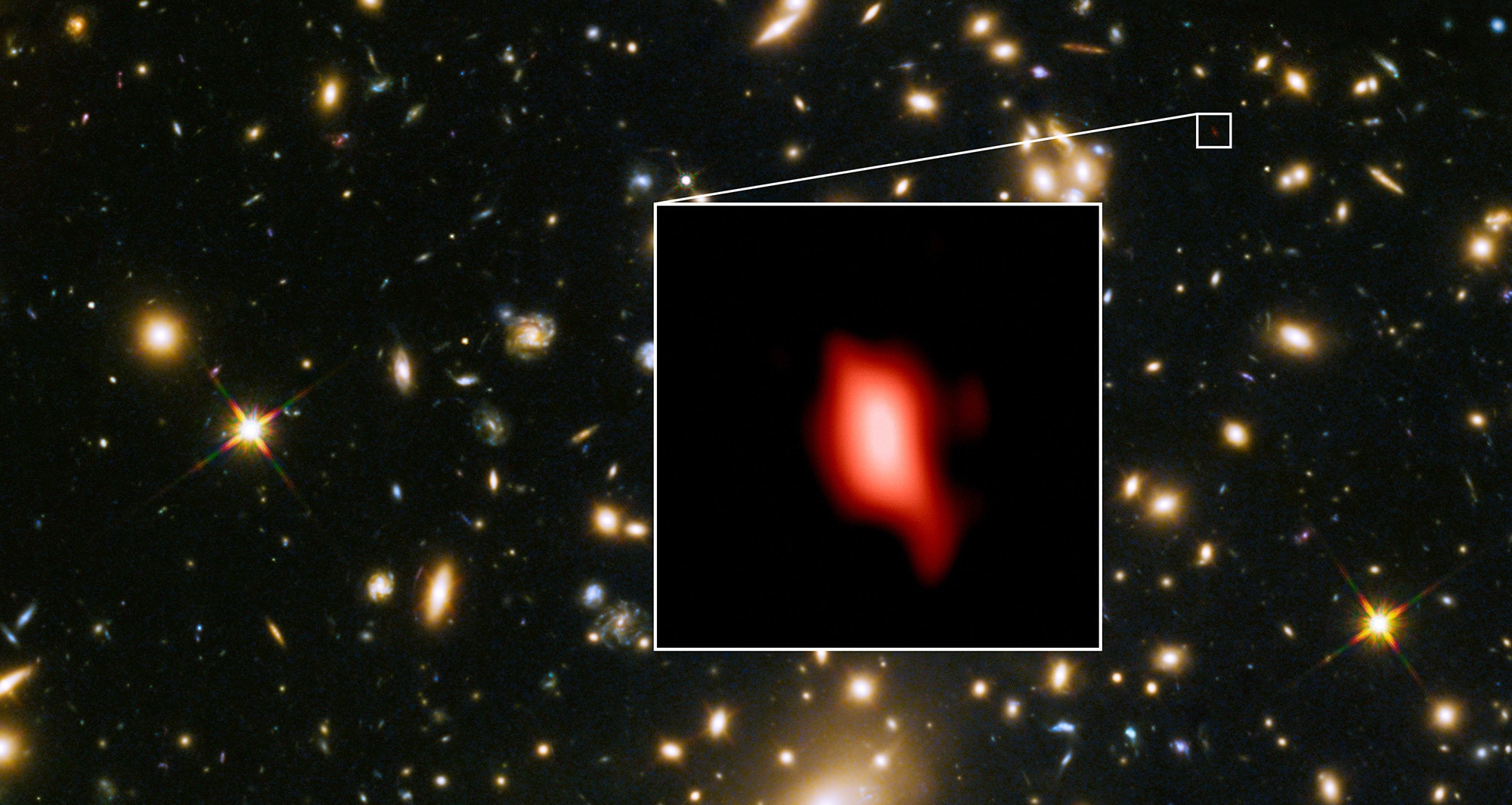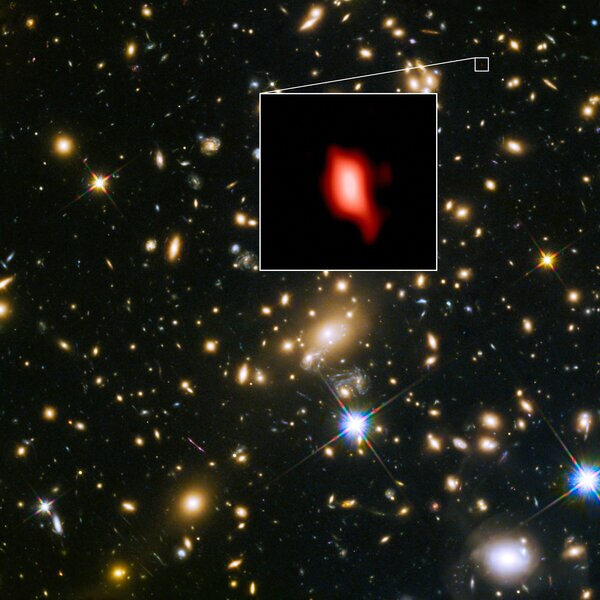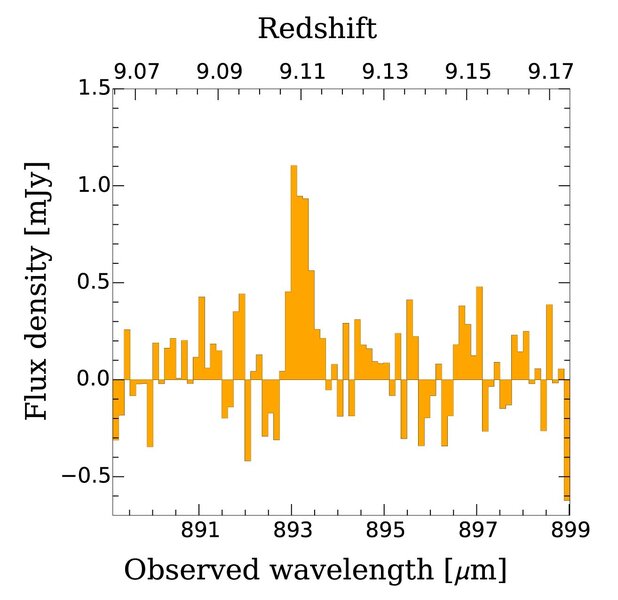Create a free profile to get unlimited access to exclusive videos, sweepstakes, and more!
A glimpse of oxygen at the edge of space reveals stars born just after the Universe itself

Astronomers have detected the existence of oxygen in an incredibly distant galaxy — about 13.3 billion light-years away — which has an amazing implication: The first stars in that galaxy formed about 250 million years after the Big Bang itself!
There are a few pieces to this story, so let me do what I love doing: explaining them.
First, the galaxy is called MACS1149-JD1. Let's call it JD1 for short. It gets that name because it appears in the sky along with a huge cluster of galaxies called MACSJ1149.5+223 (MACS is for the Massive Cluster Survey, a project to look at big, massive, and distant galaxy clusters, and the numbers are its coordinates on the sky).
However, the galaxy JD1 is not part of the cluster! It's actually far, far more distant, well in the background. Conveniently, the gravity of the cluster has magnified the light from the more distant galaxy in a process called gravitational lensing*, making JD1 easier to see.
There are a number of ways the distance to JD1 can be found, but they all rely on the fact that the Universe is expanding. As it does so, the more distant an object is, the faster it appears to move away from us. The light from that object must fight that expansion to reach us, and it loses energy as it does so. We call this the redshift, and it's similar to (though distinct from) the more familiar Doppler shift that occurs as, say, a car drives past you. The pitch of the sound made by the engine seems to be higher as it approaches and lower as it recedes; the wavelength of the sound has changed due to its motion.
This happens with light as well, so distant galaxies that are receding from us have their light's wavelength lengthened. The amount of the shift in wavelength tells us how quickly the galaxy is moving away, and that tells us its distance. The redshift is generally given as a number called z, where the amount of the shift is (1+z). So a galaxy at a redshift of, say, 5, has its wavelength elongated by a factor of 6.
The galaxy cluster is at a redshift of 0.543, putting it at a distance of about 5 billion light-years — more than a third of the way across the visible Universe! A decent but still somewhat rough estimate of JD gives a redshift of 9, putting it over 13 billion light-years distant.
How do we get a better redshift? That’s what this new work did. Knowing the approximate redshift, they searched for a particular flavor of light that galaxies like JD1 tend to emit: [OIII].
What's that? Atoms tend to emit light at very specific colors, and those colors depend on the atom. Oxygen that's been zapped by ultraviolet light loses a couple of electrons, and we call that "doubly-ionized oxygen," written as OIII (I know, that’s "3," but unionized oxygen with all its electrons is confusingly called OI, so there you go). The brackets, [OIII], refer to a physical process that goes on in the atom that isn't important there (though look up forbidden lines if you're interested; I studied them extensively for my degree).
One of the specific wavelengths of light OIII emits is at 88 microns, in the far infrared. It's very strongly given off by gas that’s been warmed by luminous stars. To see JD1 at all at its huge distance means it must be really bright, and have lots of bright stars. So looking for this line seems like a good bet.
And they found it! Using ALMA, the Atacama Large Millimeter/submillimeter Array, the astronomers doing this work saw it at a wavelength of 893 microns, stretched by a factor of about 10.1 (so that's a z of 9.1). That puts the distance of JD1 at a staggering 13.3 billion light-years away. That means the light we see from this galaxy left it when the Universe itself was only about 500 million years old. That's incredible.
As it happens, with another telescope they also detected light from hydrogen that is also redshifted by almost exactly the same amount (the difference could be due to individual motion of the gas emitting the light), corroborating the distance.
But wait! There's more!
Oxygen wasn't created in the Big Bang itself. The only elements made (about three minutes after Time Zero) were hydrogen, helium, and some lithium (and maybe trace amounts of boron). So where did the oxygen come from?
Stars. Stars fuse hydrogen into helium, and helium into beryllium and carbon, and so on. All the heavy elements we see were made in stars.
But that means the stars that made the oxygen in JD had to be born earlier in time, so they had enough time to form and live out their stellar lives, blowing out the oxygen they created. The astronomers who did the work here used physical models of how stars are born and age to determine that the stars must have been formed about 250 million years earlier than the oxygen we see in JD1, which means that the stars were born about 250 million years after the Universe itself did!
Amazing.
And very interesting in another way. This timing conflicts somewhat with previous theoretical calculations based on the observations of the cosmic microwave background (CMB) — the leftover background glow from the early Universe when it was still very hot and glowed like a star. Since that time the Universe has expanded and the glow has cooled, and you need telescopes that can see in the microwave portion of the spectrum to detect it. There are lots of things you can learn about the early Universe by studying it, including when the first stars should have switched on. That time was about 400 million years after the Big Bang, and some studies show it being even later, around 550 million years.
It's not clear to me where the discrepancy lies. Perhaps some places in the cosmos had star formation earlier than others, or either the CMB results or these new results are not quite right.
What this shows is that observations like this are hard. We're looking at very distant objects, and by nature they have to be powerhouses to be seen at all, even with very sensitive instruments. Maybe that means all we see are exceptions to the rule, until we can figure out a way to see lots more galaxies at this distance. This sort of work is cutting-edge stuff, which means we may not get solid answers for a while yet.
But either way, this forces us to think more about how the Universe formed, what it looked like when it was young, and how galaxies and stars behaved during that era. Remember, that’s us. Our galaxy formed back then, and our Sun benefited from generations of stars that came before it. Studying this is literally studying where we came from, one of the biggest scientific and philosophic questions there is.
I think that's worth digging into as deeply as we can.
* Coincidentally, that description of lensing is in an article I wrote about this same galaxy cluster! Lots of interesting stuff going on in there. Or behind there, as these cases may be.




























